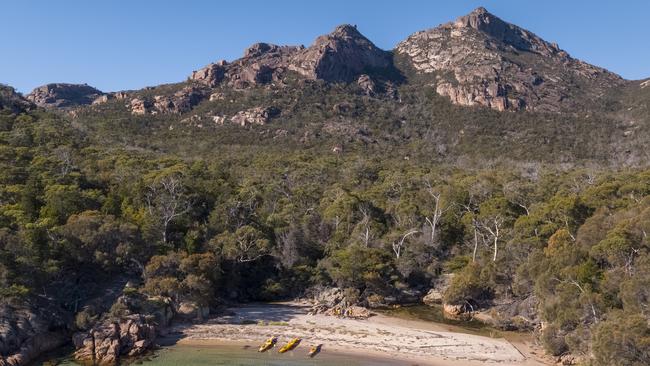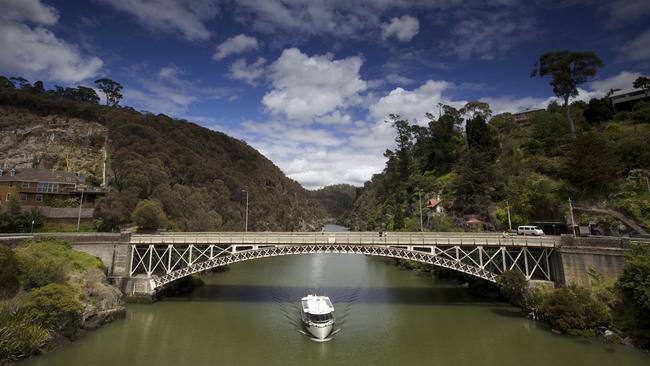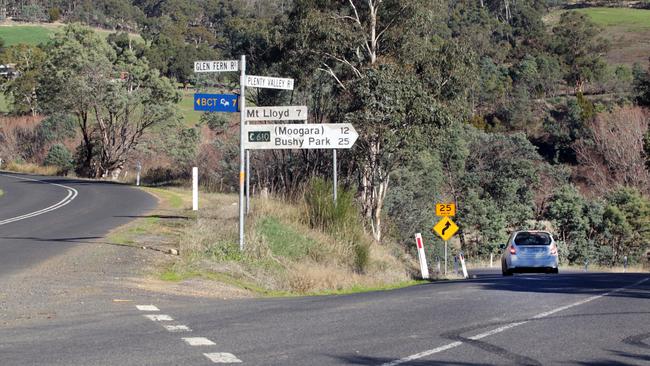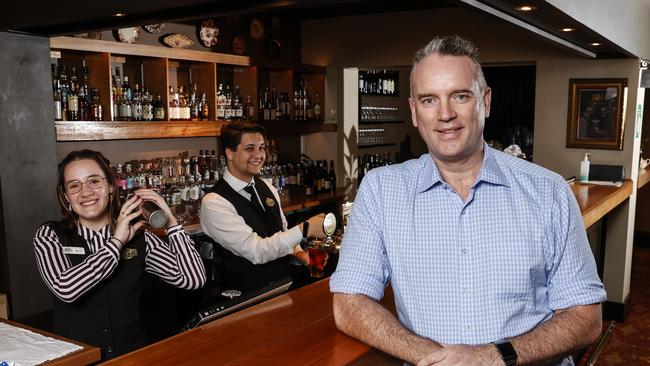GST windfall from federal budget will be a boon for state budget’s bottom line, says Deputy Premier
The federal budget has dealt Tasmania’s coffers a multibillion-dollar lucky break and will help the state government boost funding to essential services and reduce state debt.
Tasmania
Don't miss out on the headlines from Tasmania. Followed categories will be added to My News.
- What the federal budget means for Tasmania and Tasmanians
- Your 5-minute guide to tax cuts, health, jobs and education
TASMANIA’S $1.4 billion GST windfall will help fund improved health services and push the state budget back towards surplus, Deputy Premier Jeremy Rockliff says.
November’s 2020-21 budget forecast Tasmania would receive a total of $2.2bn in GST this financial year — the federal budget has revealed the figure will be $2.7bn instead — a $581m single-year improvement.
There are $322m, $268m and $250m improvements over the original forecasts in the following years – a total increase of $1.4bn.
It is an increase of between 3 and 9 per cent in the state’s revenue in each of the next four financial years.
That is $846m more than predicted as late as mid-April in the pre-election budget update, when Treasury forecast a $475m boost to the original budget estimates across the four years of the budget forward estimates.

Mr Rockliff said the federal budget was good news for the state.
“Across the board it is good for Tasmania — $846 million of additional GST revenue, of course, is very welcome, and will be invested wisely,” he said.
“That will assist us in terms of our financial management, the deficit, and of course, will ensure that that additional funding is targeted where it’s needed, such as health spending.”
Tasmania receives about 4 per cent of the total $75.1bn national pool of GST funds – with 2.1 per cent of the national population.
The formula used to share the kitty means the state receives the equivalent GST share for an “adjusted population” of 1.065m people, despite having only 543,000 residents.
In the coming financial year, Tasmanians will get $1.96 back for every dollar the state contributes.
It is the highest figure for any state, although the Northern Territory receives $4.79. NSW, by comparison receives 96c and Western Australia just 41c.
The state’s share of specific purpose payments from the federal government also increase strongly across the forward estimates: money for health and education, housing and homelessness, and local government are also predicted to rise steadily from $1.5bn in 2020-21 to $1.9 in 2023-24, an average of 8 per cent a year.
What the Federal Budget means for Tassie
JOBS, tax cuts and 70,000 new apprenticeships are at the heart of an $87bn budget cash splash to boost Australia’s economy after COVID-19.
Treasurer Josh Frydenberg is banking on the spending spree to create 250,000 jobs in two years, drive unemployment below five per cent and fast-track the nation’s great escape from its biggest financial shock since the Great Depression.
The 2021 Budget includes a $17.7bn package to overhaul aged care, $13.2bn extra for the NDIS, and a $2.3bn package to tackle mental health and suicide prevention.
Tasmania’s slice of the GST will be $400m bigger than expected in the last Federal Budget, coming in at $2.8bn for this financial year and growing to $3bn next year.
Young Australians wanting to retrain or upskill will get access to an extra 163,000 free and low-cost training courses through a $500m boost to the JobTrainer scheme, while $2.7bn will go towards creating 70,000 new apprenticeships.
Tax cuts of up to $1080 for 10 million Australians earning a low or middle income will also be extended another year at a cost of $7.8bn.
But the bold Covid-recovery strategy comes with a $1 trillion gross debt Australians will be paying off for a generation.
“This pandemic is far from over … but Australia is now well on the road to recovery,” Mr Frydenberg said in his Budget speech on Tuesday night.
“We are better placed than nearly any other country to meet the economic challenges that lie ahead,” he said.
The nation’s “economic engine” was “roaring back to life” with more people in work than before the pandemic and consumer sentiment at an 11 year high – but it has “come at a significant cost,” he said.
But rather than major budget cuts or austerity measures, the government will try to pay down debt by growing the economy through getting more people into jobs and sparking wage rises and inflation.
For the first time since before the Global Financial Crisis, unemployment is forecast to stay below five per cent for three years, falling to 4.75 per cent by 2023 and remaining at 4.5 per cent until at least 2025.
Tasmania’s unemployment rate is currently 5.9 per cent.
Wage growth will remain sluggish this year, but start to pick up over the following two years.
Childcare costs will be slashed for 250,000 families with multiple children under age five in a $1.2bn budget package, while women’s retirement savings will be boosted by axing the $450 threshold for superannuation to be paid on income.
A further $1.1bn will go towards tackling domestic violence as part of a focus on securing women’s safety, including money for more legal advice, counselling, emergency accommodation and financial support for those fleeing abusive relationships.
Up to 10,000 single parents will get help to buy a home with a deposit as low as 2 per cent under a new Family Home Guarantee.
New star ratings will be established for aged care providers as part of a sweeping overhaul of the sector in the wake of the Royal Commission – although the budget stops short of some of its recommendations.
An extra 80,000 home care packages will be funded to significantly reduce the waiting list, and 33,800 free or low cost training courses will go towards helping new and existing aged care workers boost their qualifications.
A supplement for nursing home residents’ care will also be lifted by $10 a day, among other changes.
An extra $84.5bn more tax revenue in Australia’s coffers will help pay for the new measures – including an extra $15bn nationwide for infrastructure projects designed to create jobs, such as the Midland Highway upgrades.
Tax relief for businesses worth $20.7bn will be extended another year “so a tradie can buy a new ute, a farmer a new harvester and a manufacture expand their production line,” Mr Frydenberg said.

Which Tassie electorates faired best?
By Annie McCann
Most of Tasmania’s electorates have received upwards of $100m in the latest federal budget, but the state’s capital city electorate has so far nabbed just $2m.
Largely rural electorates with massive road and infrastructure projects Lyons, Franklin and Braddon came out on top with more than $100m each, while Bass’s Tamar River clean up works scored the electorate a further $36.3m up until mid-2024.
Clark, the only independent seat in the state, received $2m for a project that was announced months before the budget was released.
Some federal funding streams have not yet been publicly assigned to specific locations in Tasmania, such as the two new Veterans Wellbeing Centres in Tasmania and South East Queensland, both costing a total of $10.7m.
Here is how Tasmania’s five electorates faired in the latest federal budget.
Clark
The independent electorate received $2m towards a Holocaust Education and Interpretation Centre in Hobart, announced by Treasurer Josh Frydenberg earlier this year during his emotional visit to the Hobart Synagogue.
Lyons
The ongoing Midland Hwy Upgrades would see Lyons receive $113.4m over the next four years.
The works will include the zone between Campbell Town and Epping Forest, Oatlands from Jericho to South of York Plains, Ross between Mona Vale Rd and Campbell Town, and other pre-construction works.
Last year’s federal budget allocated $7.14m towards the Midland Hwy Safety Works Package.
A popular East Coast holiday spot also received funding under the National Tourism Icons Package.

Tourist facilities at Freycinet received $4m in the 2020-21 financial year and will receive an extra $2.9m in 2021-22.
The Freycinet funding was announced in last year’s federal budget, with interstate locations like Rottnest Island in Western Australia and Wangetti Trail in Queensland included in the package.
Franklin
More infrastructure plans have received Federal backing in Franklin.
In the south of the electorate, the Algona Rd development has received $48m to include a grade separated interchange at the road’s roundabout and duplicating the Kingston Bypass.
At the Eastern Shore, works at Rokeby Rd and South Arm Rd have been allocated $44m.
The funds will duplicate South Arm Rd between Oakdowns and Pass Rd, while the Acton Rd intersection will also get a revamp.
Huon Link Rd, Huonville will also receive upgrades worth $13.2m.
Braddon
The Bass Hwy, which largely runs through Braddon, will get $80m for the Tasmanian Roads Package – Bass Highway Safety and Freight Efficiency Upgrades Package – Future Priorities.
That funding is complemented by another $24m for the Port of Burnie Shiploader Upgrade, which comes under the Tasmanian Freight Rail Revitalisation Tranche 3 scheme.

Bass
The Launceston City Deal has been allocated $45m in total, including $8.8m spent this financial period and an expected $12.4m for 2021-22, $16.3m for 2022-23 and $7.6m for $2023-24.

The deal consists of 12 projects aimed to reduce pollution in the Tamar River and improve aquatic health.
Long road to infrastructure funding

By Cameron Whiteley
MOTORISTS should not hold their breath for the delivery of hundreds of millions of dollars’ worth of upgrades to Tasmanian roads outlined in the Federal Budget.
A $322m roads package for the state was unveiled prior to the official release of the budget on Tuesday night, but budget papers have revealed less than a third of it will be spent over the next four years.
In fact, just $4m is expected to be spent in 2021-22 and a total of $97.2m across the forward estimates until the end of June 2025.
That date is after the next Tasmanian state election is due, with the state responsible for partially funding many of the projects.
Some of them were promised by the Tasmanian Liberals during the recent state election campaign.
Under the funding package, $113m has been set aside for upgrades to the Midland Hwy, including at Campbell Town, Oatlands and Ross.
Meanwhile, $80m will be spent on the Bass Hwy, which runs through the marginal federal seats of Bass and Braddon.
A number of other projects are being partly paid for by the state, including a major upgrade to the Algona Rd roundabout and the Kingston Bypass, which will cost a combined $60m.
The federal government will also pay $44m of a $55m project to duplicate South Arm Rd from Pass Rd to Oakdowns and to upgrade the Acton Rd intersection.
The outlining of the spending breakdown comes after federal Labor MPs criticised Liberal governments for “reheating” projects that had already been announced.
Lyons MP Brian Mitchell said funding announcements for the Bass and Midland highways were not new.
“This isn’t new funding – it’s an existing promise that has been repackaged to try and hoodwink Tasmanian voters,’’ he said.
But Tasmanian Infrastructure Minister Michael Ferguson said the funding arrangements between state and federal governments showed co-operation.
“It’s been a strong partnership between the two governments going back many years now,’’ he said.
Tasmanians to be ho-hum on budget
ANALYSIS
By David Killick
JOSH Frydenberg’s latest budget is unlikely to move the excitement metre much for Tasmanians – particularly those in the state’s south.
Headlined as “securing Australian’s recovery”, there are tax cuts and business incentives and some infrastructure spending. The aim of recovery is to get back to where we were before.
Voters should be wary when governments boast of “record funding for schools, hospitals, aged care, mental health and the NDIS”. Increasing funding for essential services year on year is a pretty baseline expectation.
It doesn’t feel like a pre-election budget, perhaps the federal government is keeping something up its sleeve.
As for stimulus: spending is down: the federal government will spend 10.6 per cent less in the coming financial year than it budgeted last year.
The budget flags $322m in infrastructure spending for Tasmania – although only $97.2m appears to be allocated across the forward estimates.
The problems with state and federal governments delivering infrastructure promises in a timely fashion are well known.
The money is a welcome handout, it conveniently funds a large tranche of the state government’s pre-election commitments before they even had a chance to ask. There’s more money for the freight equalisation scheme, a small but welcome fillip.
This is a budget which echoes the state government’s priorities: better roads and bridges, but little to tackle to long-term structural problems that keep Tasmania dependent on more than its fair share of GST largesse.
Mr Frydenberg is showing no signs of becoming the first treasurer to deliver a budget surplus since Peter Costello way back in 2009 – also the last year Australia was debt free. Spending outstrips revenue in every year for which there is a projection.
For a party that was so fond of drawing attention to Labor’s supposed “debt and deficit disaster” the Liberals are yet to deliver a balanced budget since taking office in 2013.
The next five budgets will deliver deficits totalling $502bn.
And the nation’s net debt will increase from $627bn to $980bn.
Little wonder the “debt and deficit” catchphrase has been retired.
david.killick@news.com.au

Tourism funding misses mark
By Cameron Whiteley
TUESDAY’S federal budget was a missed opportunity to further stimulate visitation to Australian destinations, Tasmania’s peak tourism industry body says.
Tourism Industry Council of Tasmania chief executive Luke Martin said he would have liked to see more ongoing support post-June for tourism which was among the worst sectors hit by the COVID-19 pandemic.
A national half-price airfares program featuring several Tasmanian destinations finishes in June while a Spirit of Tasmania passenger vehicle rebate wraps up then too, but has already been fully exhausted.
The budget did not include an extension of those programs or the introduction of similar, short to medium-term initiatives to encourage domestic tourism.
Mr Martin said that scheme has been a great success and he would like to have seen it extended beyond June, and he hoped authorities would rethink the end date.
But as things stand, he said it was disappointing both schemes were finishing at the same time.
“It’s obviously a bit of a worry for us,’’ he said.
“But I do look at things like tax credits where more discretionary spending in the pockets of Australians will hopefully encourage them to travel.”
Hadley’s Hotel chief executive Ben Targett said while the hospitality industry had a dedicated and hard-working workforce, the volume had been significantly affected by the ongoing closure of international borders.
“We’re missing an entire cohort of people who really underpin what we’re delivering ... we are just simply having difficulty manning the fort,’’ he said.
Mr Targett appealed to those who may have previously considered a career in hospitality to again think about it as an option.
He said there had been strong visitation in recent months, fuelled by the half-price airfares and more people travelling domestically.
“There are a lot of opportunities in hospitality, to travel the world and create a career,’’ he said.
Mr Targett welcomed the extension of the Job Trainer program in the federal budget, which he said may help the industry to create a bigger pool of future workers.
cameron.whiteley@news.com.au

Freight funding sets sail
TASMANIAN businesses will be able to import goods into the state from overseas more cheaply as part of an extension to the state’s freight equalisation scheme.
Tuesday night’s federal budget included $89.3m over four years from July 1 this year to extend the eligibility of the assistance scheme to goods that did not have a direct Australian-made equivalent.
The support will be applied at a rate of $700 per twenty-foot equivalent unit.
The Commonwealth said this would provide greater assistance to the Tasmanian agriculture, forestry and fisheries, manufacturing and mining industries.
In budget papers, the federal government said the cost of the new measure would be partly met from within the existing resources of the Department of Infrastructure, Transport, Regional Development and Communications.
Federal Liberal Braddon MP Gavin Pearce said the policy would be a game-changer for Tasmania and many of its industries.
“The flow on benefits to Tasmania’s economy, at a time when we need it most, cannot be overstated,’’ he said.
“This funding will drive Tasmanian industry’s bottom line, will potentially attract new industry to the state, will increase investment, and crucially increase employment opportunities right across Tasmania.”
It is an extension of the long-running Tasmanian Freight Equalisation Scheme, which seeks to lower the cost to Tasmanian businesses of transporting goods across Bass Strait.
The scheme was introduced in 1976.
Budget papers show $174m was expected to be spent on the program during the current financial year and slightly more in 2021-22.
A financial year-to-date total of $121m had been spent on the scheme to the end of March, with Simplot, Mccain and Norske Skog the top three claimants during the first three months of 2021.
Meanwhile, the government provided $6m in 2020-21 to increase the rebate for the Bass Strait Passenger Vehicle Equalisation Scheme for free travel for eligible passenger vehicles across Bass Strait between March 1 and June 30 this year, to stimulate tourism business recovery in Tasmania.
The budget papers do not suggest this scheme will be extended beyond that date.



